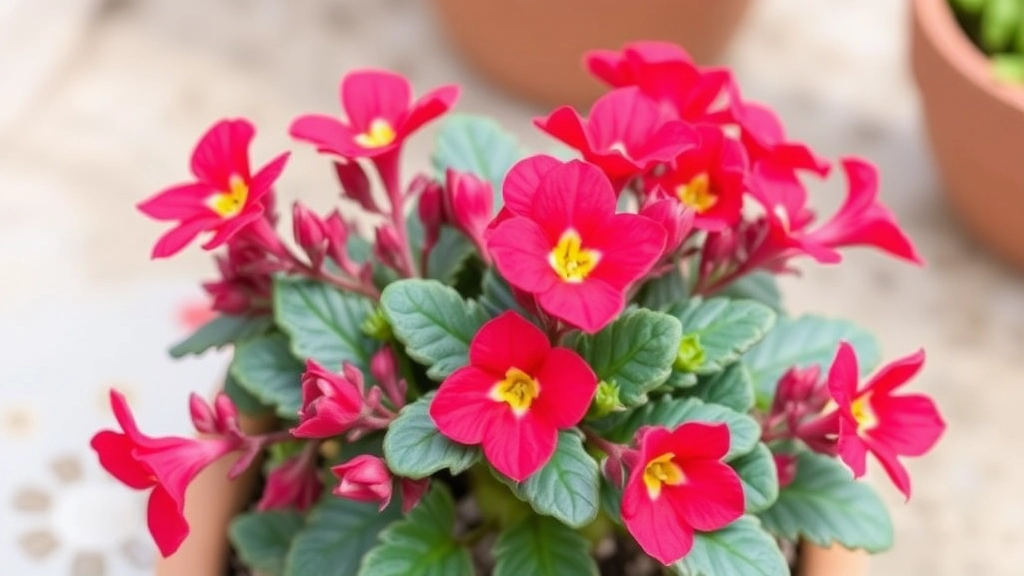Kalanchoe Red Flower Plant Care Guide
Having a Kalanchoe Red Flower Plant in your home is like adding a splash of vibrant colour to your living space. This low-maintenance plant not only beautifies your surroundings but also brings a touch of nature indoors. If you’re looking to create a point of interest in your home decor, the Kalanchoe Red Flower Plant is a fantastic choice.
In this guide, I’ll walk you through the steps to care for your Kalanchoe Red Flower Plant, ensuring it stays healthy and blooms beautifully. From watering tips to ideal lighting conditions, you’ll find everything you need to keep your plant thriving. Let’s dive in and make your Kalanchoe Red Flower Plant the star of your home!
Characteristics of Kalanchoe Red Flower Plant
Are you curious about what makes the Kalanchoe Red Flower Plant stand out? This vibrant succulent is not just a feast for the eyes; it also possesses unique traits that make it a popular choice among plant enthusiasts.
Distinctive Features
- Foliage: The Kalanchoe boasts thick, fleshy leaves that can vary in shape, often featuring scalloped edges. Their glossy surface adds to the plant’s appeal.
- Flowers: As the name suggests, the Kalanchoe is renowned for its stunning red flowers. These clusters bloom in vibrant hues, creating a striking contrast against the green leaves.
- Growth Habit: This plant typically grows upright and can reach heights of around 30 to 45 cm. Its bushy nature makes it an attractive addition to any space.
- Lifespan: With proper care, Kalanchoe can live for several years, providing lasting beauty and enjoyment.
Resilience and Adaptability
Kalanchoe plants are known for their resilience. They can adapt to various environments, making them suitable for both novice and experienced gardeners. They thrive in moderate conditions but can also withstand periods of neglect. For more detailed care tips, check out our ultimate guide on caring for Kalanchoe succulents. Additionally, if you’re interested in propagation, our step-by-step guide on propagating Kalanchoe in water is a must-read.
Ideal Growing Conditions for Kalanchoe Red Flower Plant
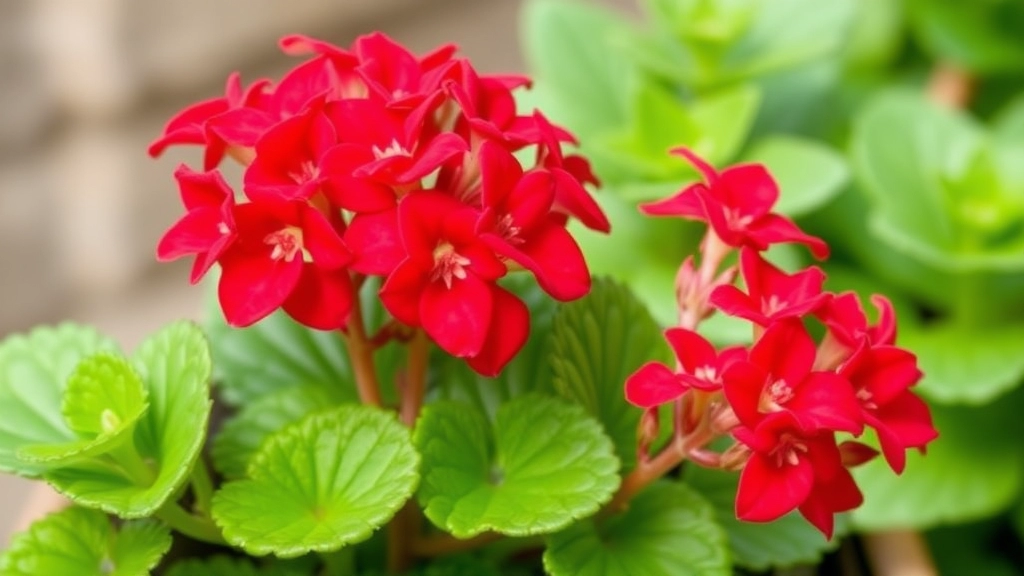
So, you’re excited about growing the Kalanchoe Red Flower Plant, but what conditions do you need to nail down for it to thrive?
Let’s talk about the ideal environment to create a happy home for your plant.
Temperature
- Warmth is Key: Kalanchoe loves warmth. Aim for temperatures between 20°C to 25°C (68°F to 77°F).
- Avoid Chills: Keep it away from cold drafts or temperatures below 10°C (50°F).
Humidity
- Moderate Levels: This plant prefers moderate humidity. Too much moisture can lead to issues.
- Dry Air? No Problem: It can handle dry air, making it perfect for indoor settings.
Air Circulation
- Breathe Easy: Good air circulation is essential to prevent fungal diseases.
Space
- Room to Grow: Make sure it has enough space to spread its leaves without crowding.
When considering the Kalanchoe Red Flower Plant, one of the most common concerns is the right soil and potting conditions.
### Soil Type
Choosing the right soil is crucial for the health of your Kalanchoe.
– **Well-Draining Soil**: The plant thrives in a well-draining mix, ideally a cactus or succulent potting mix.
– **pH Level**: Aim for a slightly acidic to neutral pH of around 6.0 to 7.0.
### Potting Essentials
Next, think about the pot itself.
– **Drainage Holes**: Ensure your pot has adequate drainage holes to prevent waterlogging.
– **Size**: Choose a pot that is slightly larger than the root ball, allowing room for growth.
### Repotting Tips
Repotting is essential for maintaining a healthy plant.
– **Frequency**: Consider repotting every 2-3 years or when the plant outgrows its pot.
– **Timing**: The best time to repot is during the spring when the plant is actively growing.
For more detailed care tips, you can refer to our [complete guide to growing Kalanchoe Pink Butterflies](https://planthq.org/complete-guide-to-growing-kalanchoe-pink-butterflies/) and [how to care for Kalanchoe Flapjack](https://planthq.org/how-to-care-for-kalanchoe-flapjack-complete-guide/).
Watering and Humidity Needs
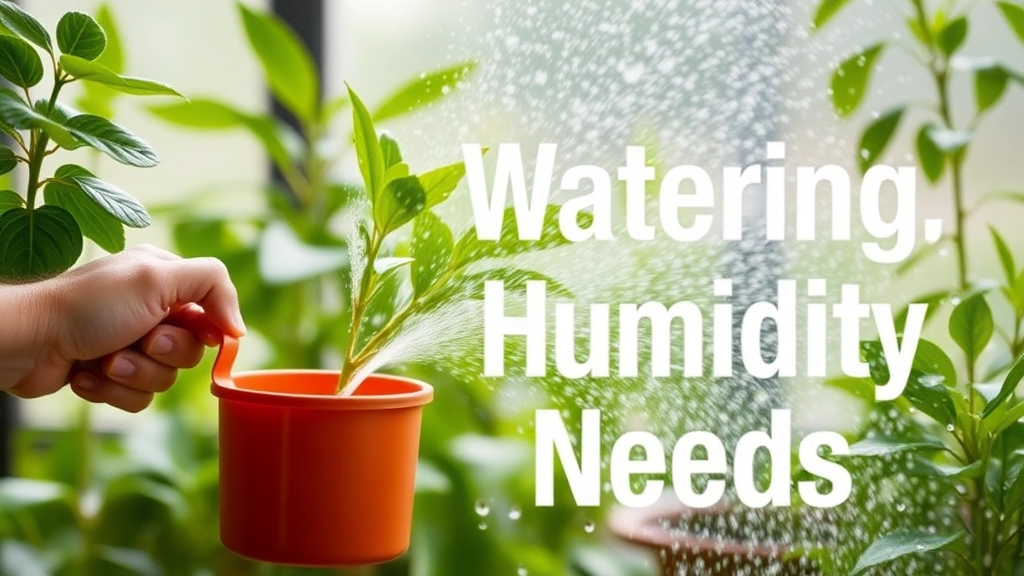
When it comes to caring for your Kalanchoe Red Flower Plant, understanding its watering and humidity needs is crucial. Overwatering is a common concern for many plant enthusiasts.
Watering Guidelines
- Frequency: Water your Kalanchoe when the top inch of soil feels dry. This typically means watering every 1-3 weeks, depending on environmental conditions.
- Method: Always water thoroughly, allowing excess water to drain out of the pot. This prevents root rot, which can be detrimental to your plant.
- Seasonal Adjustments: During the growing season (spring and summer), your plant may require more frequent watering. In contrast, reduce watering in the dormant months (fall and winter).
Humidity Requirements
- Ideal Humidity: Kalanchoe prefers low to moderate humidity levels. Ideally, aim for a humidity range of 40-60%.
- Indoor Tips: If you live in a particularly dry climate, consider placing a small humidifier nearby or grouping your plants together to create a micro-humidity environment.
- Signs of Low Humidity: If you notice browning leaf edges or wilting, it may indicate that the air is too dry.
Light Requirements
When it comes to growing the Kalanchoe Red Flower Plant, one of the most common concerns is its light requirements.
How much light does it really need?
Kalanchoe thrives in bright, indirect sunlight.
Here are some essential tips for ensuring your plant gets the right amount of light:
- Location: Place your Kalanchoe near a south or west-facing window. This will provide ample light without the harsh direct sun that can scorch its leaves.
- Duration: Aim for at least 6 hours of light daily. If natural light is limited, consider using grow lights to supplement.
- Signs of Too Much or Too Little Light:
- Too Much Light: Leaves may become scorched, turning brown or crispy.
- Too Little Light: The plant may become leggy, with elongated stems and sparse leaves.
- Seasonal Changes: Be mindful of changing light conditions with the seasons. In winter, you might need to rotate your plant or move it closer to the window.
For more detailed care tips, check out our Ultimate Guide to Variegated Kalanchoe Care Tips and learn how to ensure your plant thrives year-round.
If you’re looking to expand your collection, don’t miss our guide on Kalanchoe Pink Butterflies for Sale, which includes the best prices and care tips for this unique variety.
Fertilization Tips for Your Kalanchoe Red Flower Plant
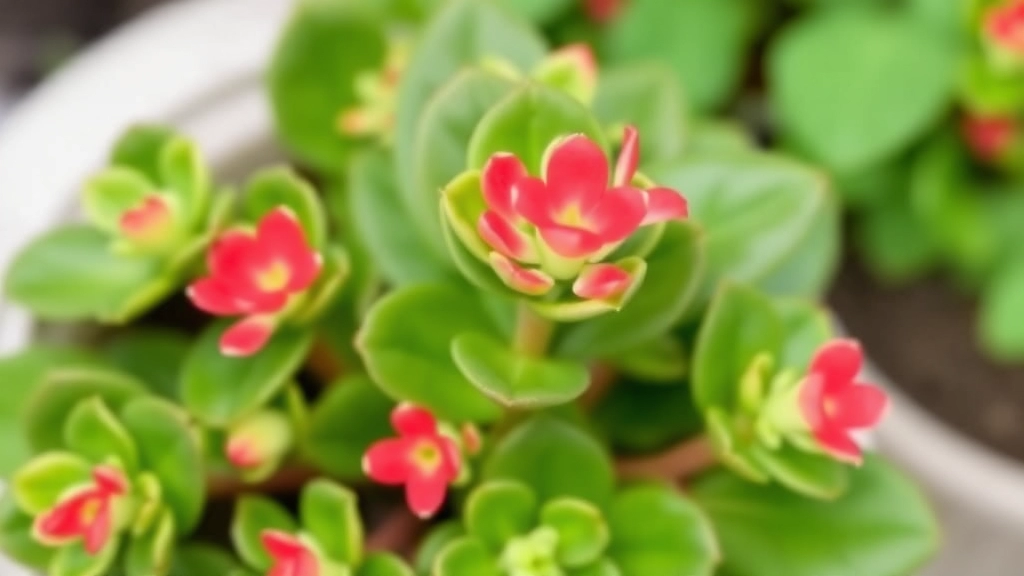
So, you’ve got your Kalanchoe Red Flower Plant thriving, but how do you keep it blooming beautifully?
Fertilization is key to ensuring your plant stays vibrant and healthy.
Here’s the lowdown on how to feed your Kalanchoe without overwhelming it:
- Choose the Right Fertilizer:
- Go for a balanced, water-soluble fertiliser, like a 20-20-20 or a specific succulent mix.
- Frequency of Feeding:
- During the growing season (spring and summer), feed every 4-6 weeks.
- In autumn and winter, cut back to once every 2-3 months since the plant is resting.
- Dilution is Crucial:
- Always dilute the fertiliser to half the recommended strength. Too much can burn the roots.
- Application Method:
- Water your plant first, then apply the diluted fertiliser. This helps prevent any root damage.
- Signs of Over-Fertilization:
- Watch for yellowing leaves or stunted growth. If you see these, flush the soil with water to remove excess nutrients.
Remember, a little goes a long way!
Common Pests and Diseases
As you nurture your Kalanchoe Red Flower Plant, you may encounter some common pests and diseases that can hinder its growth. Recognising these issues early on is crucial for maintaining a healthy plant.
VIII. Pruning and Maintenance of Kalanchoe Red Flower Plant
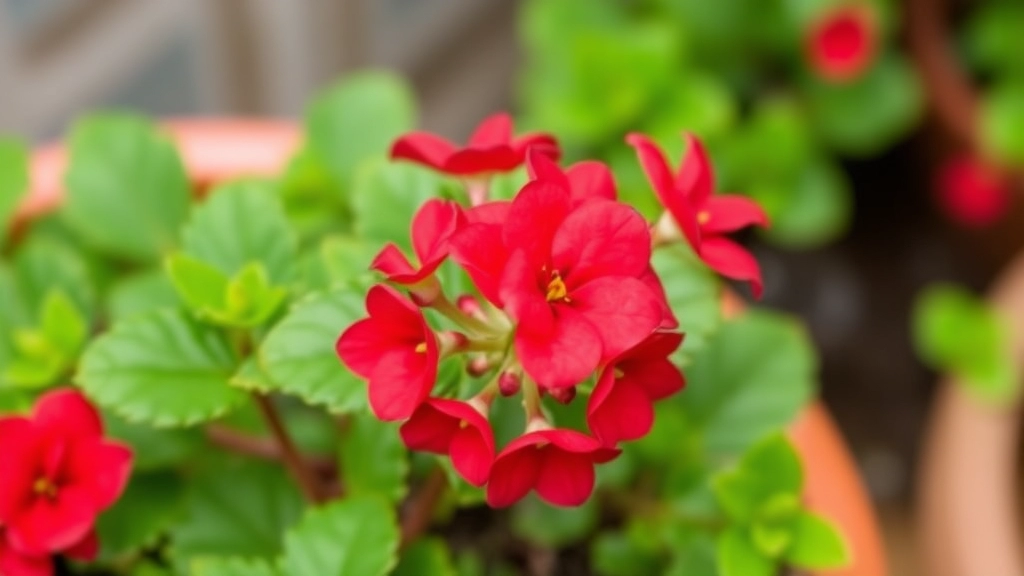
So, you’ve got your Kalanchoe Red Flower Plant thriving, and now you’re wondering how to keep it looking its best.
Pruning is your secret weapon for a healthy, vibrant plant.
Why Prune?
- Encourages Growth: Snipping off dead or wilting leaves helps stimulate new growth.
- Shaping: Keeping the plant tidy and bushy enhances its aesthetic appeal.
- Disease Control: Removing affected parts can prevent the spread of pests and diseases.
When to Prune
- After Flowering: The best time to prune is right after the blooming period. This allows the plant to focus its energy on new growth.
- Regular Maintenance: Check your plant every few weeks. If you see any dead leaves or spent flowers, don’t hesitate to prune them away.
How to Prune
- Use Clean Tools: Always use sharp, clean scissors or pruning shears to avoid introducing bacteria.
- Cut at the Base: For spent flowers, cut just above the first set of healthy leaves.
- Trim Sparingly: Don’t go overboard; a little trim goes a long way.
Maintenance Tips
- Dust Off the Leaves: Wipe the leaves with a damp cloth to keep them dust-free. This helps the plant absorb light better.
- Rotate Your Plant: Every couple of weeks, give your Kalanchoe a gentle turn. This ensures even growth and exposure to light.
Propagation Methods
Are you looking to expand your collection of Kalanchoe Red Flower Plants?
Propagation is a rewarding way to grow new plants from your existing ones.
1. Leaf Cuttings
- Select a Healthy Leaf: Choose a mature, healthy leaf from the parent plant.
- Cut and Dry: Use a clean, sharp knife to cut the leaf. Allow it to dry for a few days until the cut edge forms a callus.
- Planting: Place the callused leaf in well-draining soil. Water sparingly until roots develop.
2. Stem Cuttings
- Choose a Stem: Opt for a healthy stem with at least a few leaves.
- Cut and Dry: Cut the stem just below a leaf node and let it dry for a short period.
- Soil Placement: Insert the cut end into soil, ensuring it’s stable. Water lightly.
3. Offsets
- Identify Offsets: Look for small offsets or pups growing at the base of the parent plant.
- Remove Carefully: Gently twist or cut them away from the parent.
- Replant: Plant the offsets in their own pots with suitable soil.
4. Seeds
- Sowing Seeds: If you have seeds, scatter them on the surface of moist soil.
- Humidity: Cover lightly with plastic to maintain humidity until germination occurs.
- Lighting: Once seedlings emerge, provide adequate light.
Propagation not only allows you to grow new plants but also strengthens your gardening skills. For more detailed guidance, check out our step-by-step guide on growing Kalanchoe from leaf cuttings and our complete guide to florist Kalanchoe propagation.
Seasonal Care Guidelines for Kalanchoe Red Flower Plant
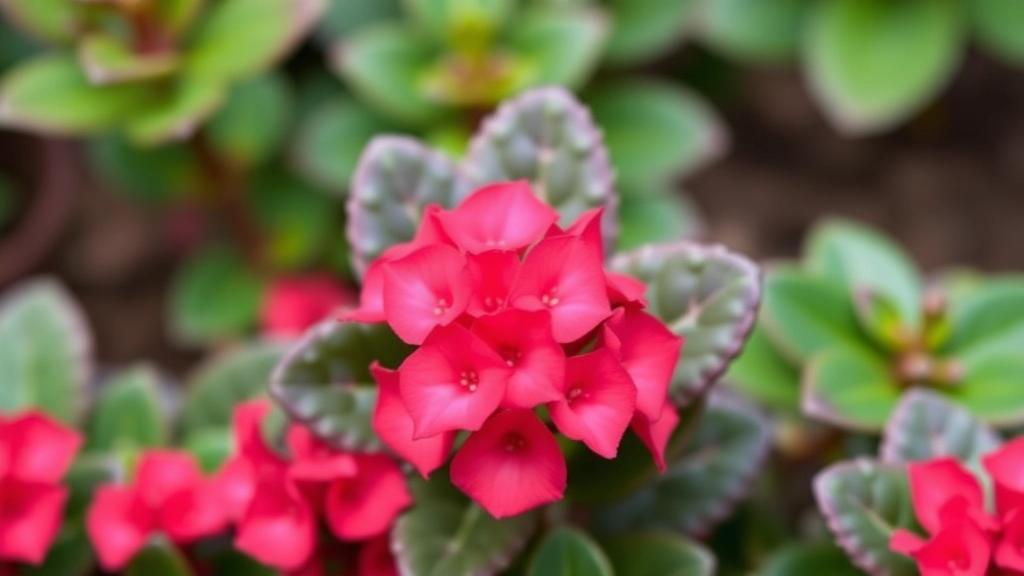
So, you’ve got your Kalanchoe Red Flower Plant thriving, but how do you keep it happy throughout the seasons?
Let’s break down some straightforward seasonal care tips to ensure your plant remains vibrant all year round.
Spring: Time for Growth
- Repotting: Spring is the perfect time to repot if your Kalanchoe has outgrown its pot. Choose a slightly larger pot to give those roots some breathing space.
- Fertilization: Start feeding your plant with a balanced fertiliser every 4-6 weeks to support its growth.
- Pruning: Trim away any dead or wilted leaves to encourage new growth.
Summer: The Sunshine Season
- Watering: Increase your watering frequency as temperatures rise. Keep the soil slightly moist but never soggy.
- Light: Ensure your Kalanchoe gets plenty of bright, indirect sunlight. Too much direct sun can scorch those beautiful leaves.
- Humidity: If it’s particularly dry, consider misting your plant occasionally.
Autumn: Preparing for Dormancy
- Watering: Gradually reduce watering as the weather cools. Let the top inch of soil dry out between waterings.
- Fertilization: Cut back on fertiliser as the plant slows down for the season.
- Pruning: This is a good time to shape your plant and remove any spent flowers.
Winter: The Quiet Months
- Light: Keep your plant in a well-lit spot, as it still needs some sunlight, even in winter.
- Watering: Water sparingly. Your Kalanchoe is in a dormant phase, so it doesn’t need much moisture.
- Temperature: Protect your plant from cold drafts. Ideal temperatures are between 15-20°C (59-68°F).
Indoor vs. Outdoor Growth of Kalanchoe Red Flower Plant
When considering whether to grow your Kalanchoe Red Flower Plant indoors or outdoors, many questions arise.
Indoor Growth:
Growing Kalanchoe indoors offers several advantages:
- Controlled Environment: You can manage temperature and humidity easily.
- Pest Management: Indoor plants are less susceptible to outdoor pests.
- Accessibility: Enjoy the beauty of Kalanchoe all year round.
However, indoor growth requires careful attention to light conditions.
- Bright, Indirect Light: Place your Kalanchoe near a window where it receives ample light without harsh direct sun.
- Temperature: Aim for a consistent temperature between 15°C to 24°C.
Outdoor Growth:
On the other hand, outdoor cultivation can be equally rewarding:
- Naturally Light: Kalanchoe thrives in bright sunlight, which can enhance flowering.
- Space: Outdoor gardens often provide more room for growth.
Yet, outdoor plants face challenges:
- Weather Sensitivity: Kalanchoe is sensitive to frost; ensure it’s planted after the last frost date.
- Pest Exposure: Outdoor plants may encounter more pests and diseases.
Key Considerations:
- Seasonal Changes: Indoor plants can be moved outdoors in warmer months, but be cautious of sudden temperature shifts.
- Potting: Use pots with drainage holes for both indoor and outdoor growth to prevent root rot.
For more detailed care tips, check out our guide on caring for Kalanchoe with red flowers and our article on optimal light conditions for Kalanchoe.
Benefits of Growing Kalanchoe Red Flower Plant
So, why should you even consider adding a Kalanchoe Red Flower Plant to your collection?
Well, let me tell you, this vibrant little beauty isn’t just a pretty face.
Aesthetic Appeal
- Stunning Blooms: The bright red flowers can instantly brighten up any space.
- Versatile Decor: Whether it’s on your windowsill or as a centerpiece, it fits right in.
Low Maintenance
- Easy Care: Kalanchoes are forgiving plants, perfect for those who might not have a green thumb.
- Drought Tolerant: They don’t need constant watering, making them ideal for busy lifestyles.
Air Purification
- Cleaner Air: Like many houseplants, Kalanchoes can help improve indoor air quality. They absorb toxins and release oxygen.
Medicinal Properties
- Traditional Uses: In some cultures, Kalanchoe is known for its medicinal properties, believed to help with various ailments.
Year-Round Blooms
- Long Blooming Season: With the right care, you can enjoy their flowers for months on end. For more tips on how to make your Kalanchoe bloom, check out our guide on how to make Kalanchoe bloom all summer.
Cost-Effective
- Affordable: They’re usually quite inexpensive, so you can easily add a splash of colour without breaking the bank. If you’re interested in other varieties, you might enjoy learning about popular long-stem Kalanchoe varieties and their care tips.
FAQs about Kalanchoe Red Flower Plant
What are the ideal growing conditions for a Kalanchoe Red Flower Plant?
The Kalanchoe Red Flower Plant thrives in warm temperatures between 20°C to 25°C (68°F to 77°F) and prefers moderate humidity. Ensure good air circulation and provide enough space for the plant to spread its leaves.
How often should I water my Kalanchoe Red Flower Plant?
Water your Kalanchoe when the top inch of soil feels dry, typically every 1-3 weeks. During the growing season (spring and summer), you may need to water more frequently, while in fall and winter, reduce watering.
What type of fertilizer should I use for my Kalanchoe Red Flower Plant?
Use a balanced, water-soluble fertilizer like a 20-20-20 mix or a specific succulent fertilizer. Feed every 4-6 weeks during the growing season and reduce to once every 2-3 months in autumn and winter.
When is the best time to prune my Kalanchoe Red Flower Plant?
The best time to prune is right after the blooming period. Regular maintenance pruning can also be done every few weeks to remove dead leaves or spent flowers.
How do I maintain my Kalanchoe Red Flower Plant throughout the year?
Seasonal care tips include repotting and fertilizing in spring, increasing watering and ensuring bright indirect sunlight in summer, reducing watering and fertilizing in autumn, and providing adequate light and minimal watering in winter.
What are the signs of over-fertilization in a Kalanchoe Red Flower Plant?
Signs of over-fertilization include yellowing leaves and stunted growth. If you notice these symptoms, flush the soil with water to remove excess nutrients.
Can Kalanchoe Red Flower Plants handle dry air?
Yes, Kalanchoe Red Flower Plants can handle dry air, making them suitable for indoor settings. However, if you live in a particularly dry climate, consider using a small humidifier or grouping plants together to create a micro-humidity environment.
Why is air circulation important for my Kalanchoe Red Flower Plant?
Good air circulation is essential to prevent fungal diseases and ensure the overall health of the plant.
How can I tell if my Kalanchoe Red Flower Plant needs more humidity?
If you notice browning leaf edges or wilting, it may indicate that the air is too dry, and you might need to increase humidity levels around the plant.
What should I do if my Kalanchoe Red Flower Plant’s leaves are dusty?
Wipe the leaves with a damp cloth to keep them dust-free. This helps the plant absorb light better and maintain its health.
References
-
Growing Kalanchoe Indoors
-
Kalanchoe Care: Growing Kalanchoe Plants Indoors
-
Kalanchoe: How to Grow and Care for Kalanchoe Plants
